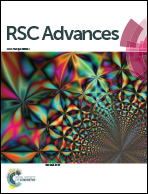In situ synthesized single-crystalline LiMn2O4 embedded in carbon nanotube films as free-standing cathodes for Li-ion batteries†
Abstract
Single-crystalline LiMn2O4 nanoparticles embedded in a carbon nanotube film (LMO–CF-in situ), which serves as a binder-free and self-standing cathode for lithium ion batteries (LIBs), is synthesized by an in situ hydrothermal reaction followed by heat treatment. The single-crystalline LiMn2O4 particles with a diameter of about 200–400 nm are homogeneously distributed and entrapped in the mechanically robust and highly conductive carbon nanotube (CNT) scaffolds, which not only improves the energy density by eliminating the use of conventional metal current collectors, polymer binders and conductive additives, but also effectively alleviates the aggregation of LiMn2O4 nanoparticles. The as-synthesized LMO–CF-in situ electrode exhibits attractive rate capability with an 86.2% retention of the capacity at 1C achieved at 5C, excellent cycling stability with an 82.1% specific capacity retention after 300 cycles at 1C and high coulombic efficiency of nearly 100%.


 Please wait while we load your content...
Please wait while we load your content...